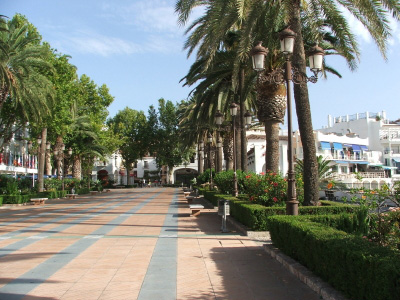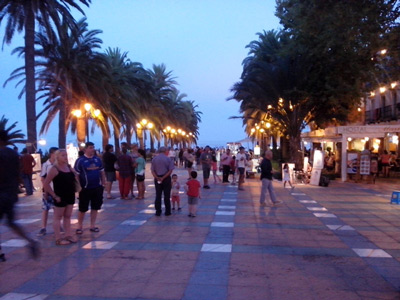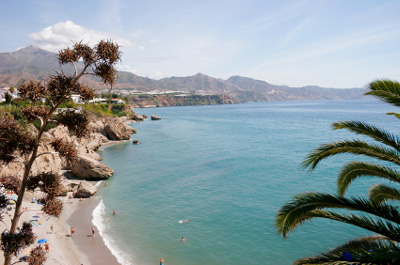0034 686009408
info@villasolrealestate.com



Nestled along the stunning Costa del Sol in southern Spain, the town of Nerja is a captivating destination that holds a rich historical tapestry. From its ancient origins to the Roman and Moorish influences, Nerja's past is etched into its landscapes and structures. Among the notable landmarks that have played a significant role in its history are the Caves of Nerja, the Viaduct, and the castle that once stood proudly on the Balcon de Europa.
The story of Nerja's history stretches back thousands of years, with evidence of human habitation dating back to the Paleolithic era. Within the region, prehistoric cave paintings have been discovered, showcasing the presence of ancient communities who sought shelter and inspiration within the natural caves that dot the area.
One of the most renowned attractions in Nerja is the Caves of Nerja, a vast network of underground caverns. Discovered by a group of local boys in 1959, these caves have become a remarkable archaeological and tourist site. With formations of stalactites and stalagmites that have evolved over millions of years, the Caves of Nerja offer a surreal underground landscape that leaves visitors in awe. The archaeological excavations conducted within the caves have unearthed remnants of Paleolithic, Neolithic, and Bronze Age civilizations, providing valuable insights into the ancient cultures that once thrived in the region.
Moving forward in history, the Roman period brought significant changes to Nerja. The Romans recognized the strategic location of the town along the coast and established a settlement known as Detunda. Evidence of Roman influence can still be seen today, with remnants such as a fish salting factory and a mosaic floor near the Balcon de Europa. This iconic promenade, which offers breathtaking views of the Mediterranean Sea, was once the site of a castle that overlooked the town.
The castle that once stood on the Balcon de Europa played a vital role in Nerja's history. Originally constructed during the 9th century by the Moors, it provided a vantage point for defending the town. Over the centuries, it underwent several modifications under different rulers, including the Christians during the Reconquista. However, during the 19th century, the castle was tragically destroyed by British forces to prevent it from being used as a stronghold against them. Today, the Balcon de Europa stands as a scenic spot, a symbol of Nerja's resilience and a gateway to its captivating past.
Another remarkable structure in Nerja is the Viaduct, also known as the Aqueduct of Eagle's Nest. Built during the late 19th century under the reign of King Alfonso XII, this impressive bridge spans the River Chillar's ravine, connecting Nerja to the neighboring town of Maro. The Viaduct not only facilitated transportation and trade but also stands as a testament to Nerja's architectural ingenuity.
Nerja's history has played a pivotal role in shaping its identity as a cultural and tourist destination. The town's transformation from a fishing village to a thriving coastal town has been driven by its rich historical heritage. Today, visitors can explore the ancient wonders of the Caves of Nerja, marvel at the architectural feats of the Viaduct, and appreciate the remnants of the castle on the Balcon de Europa. As they delve into Nerja's history, they become part of a journey that connects the past with the present, offering a glimpse into the vibrant tapestry of this enchanting town on the Costa del Sol.
Nerja is the Costa del Sol's most easterly resort, 50 km from Malaga airport. Originally a sleepy fishing village it is now a thriving all year round holiday and residential resort but Nerja has managed to retain much of its original character and charm. It is still at heart a Spanish village and the old part of the town has narrow, winding streets with whitewashed houses. In amongst these streets you can find shops selling local art and craftwork, typical jewellery and local products and a huge selection of bars and restaurants that range from cheap and cheerful tapas bars to fine dining restaurants for that special occasion.
One of the many reasons foreigners choose Nerja as a holiday destination or a place to live is the many fiestas and festivals that Nerja celebrates throughout the year, from the 3 Kings celebration parade on 5th January, Nerja Carnival in March/April to the biggest beach party in Spain on 23rd of July to Celebrate San Juan and of course Nerja Feria the second week in October there is pretty much a fiesta every month of the year.
June is really the start of summer here and Nerja and the only the only chance to camp on the beach is on June 23rd.

The festival of San Juan is 24th June but the night before there will be lots and lots of people on the beach with barbecues and tents. Held to celebrate the longest day (24th is when the nights start to get shorter) and bonfires are lit to try and persuade the sun not to set early.
At midnight people run into the sea, or at least wet their heads three times and then jump over a fire. All part of Pagan origins but a geat excuse for a party!
A new mini-train for tourists will connect Nerja caves with the town's historic centre. The scenic route will also feature a stop at the small fishing village of Maro with the aim of boosting trade there, as well as at Verano Azul park. The announcement was made after an agreement between the president of Nerja caves, Jorge Hernandez Molar, and Nerja mayor Jose Alberto Armijo. An audio guide offering information about the various places and monuments passed on the journey will be included.

Built on the site of a 9th Century Moorish fortress the Balcon de Europa, in the heart of Nerja, is a beautiful viewing point overlooking the sea with spectacular views of cliffs all along the coastline and of the pretty coves and small beaches below. Local legend would have us believe that is was so named by King Alfonso XII who when visiting in 1885 following a disastrous earthquake stood at the end of the Balcon and reputedly said "This is the balcony of Europe". There is a life size statue of the king standing by the railing.From here you can also see the spectacular mountains of the Sierra de Almijara. The avenue leading to it is lined with palm trees and benches and provides a shady respite from the hot sun and you will often see locals sitting around and chatting. This is the heart of Nerja and on an evening people love to promenade and look at the views from the Balcon and wander past the the 17th Century El Salvador Church.
Only 3 km from the town you will find the main tourist attraction of the area, the Caves of Nerja. They contain many impressive stalactites and stalagmites and an enormous cavern which is used for concerts during the summer months. There are also a number of 20,000 year old paintings which unfortunately are in the restricted area.
Given that many visitors come to the Costa del Sol for the beaches Nerja is a perfect choice with 1.5 km of sandy beaches the best of which is thought to be Burrianna beach at the far east of the town which has been awarded the Blue flag of the European Union on various occasions but there are many small, beautiful beaches for those looking for something more quaint, such as Calahonda beach to the left of the Balcon. As in most of the resorts on the Costa del Sol there is a full range of water sports available in Nerja including water skiing, scuba diving and canoeing.

The countryside around Nerja offers those not wanting to spend all their time on the beach a range of other activities. You can go walking in the Axarquia where there are plenty of trails for walkers of varying levels. You can get information and maps from the tourist office in Nerja which can be found just of the Balcon de Europa or if you would prefer to go on some organised, guided walks from Nerja. You can also go cycling or mountain biking, horse riding, paragliding or take a jeep safari. There are two options for anyone wishing to camp, the campsite on the outskirts of the town or a less organised camping area in the park above the caves.
For those looking for nightlife you should go to Tuti Fruti Square where the disco pubs are located. Many are run by English speaking people so it should be no problem to order what you want.
Nerja has much to offer for food lovers such as a wide range of fish restaurants all the way along Burriana beach where you can sample local specialities such as pescaito frito (Fried fish) and paella, many traditional tapas bars situated in the old part of the town which give a free tapa with every drink and a large number of international restaurants eg, Greek, Mexican and Indian with prices and menus to suit everyone.

Many of the traditional festivals are still celebrated in Nerja some of which include the town feria between 8th October and 12th October, Holy week and the festival of San Isidro celebrated on May 15th with a parade starting at the Balcon de Europa and ending at the caves with a big country style party.
Situated between the Sierra de Almijara mountains and the sparkling waters of the Mediterranean Nerja enjoys one of the best climates in Europe with around 320 days of sunshine each year. The summer temperatures tend to be around 30ºC whilst in winter they are around 20ºC and this allows for sunbathing for about 9 months of the year. These mild winter temperatures allow residents and visitors alike to enjoy an outdoor life all year round. For more details see our Nerja Weather page.